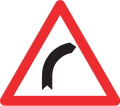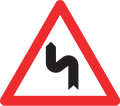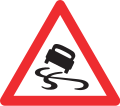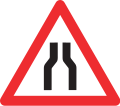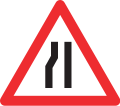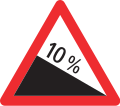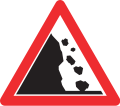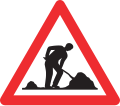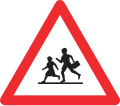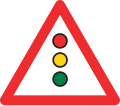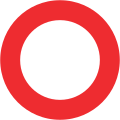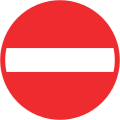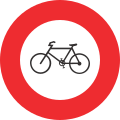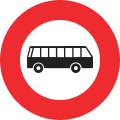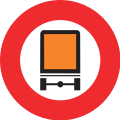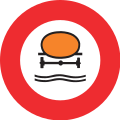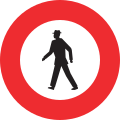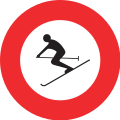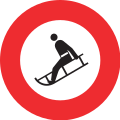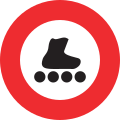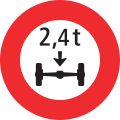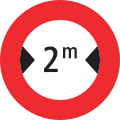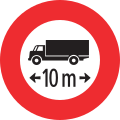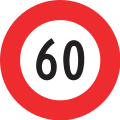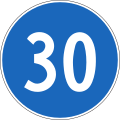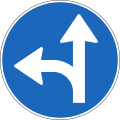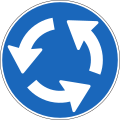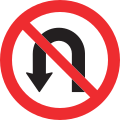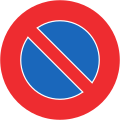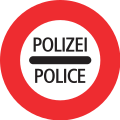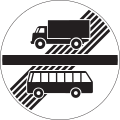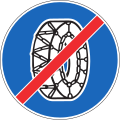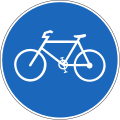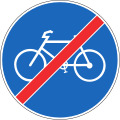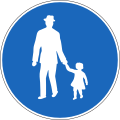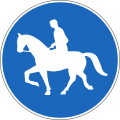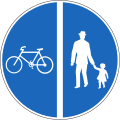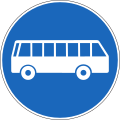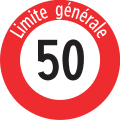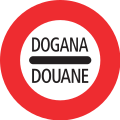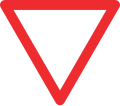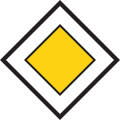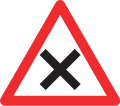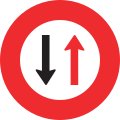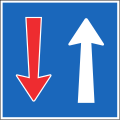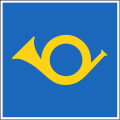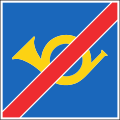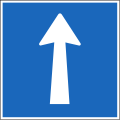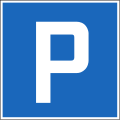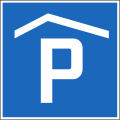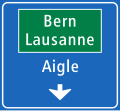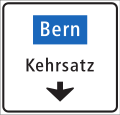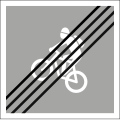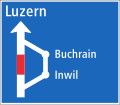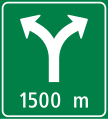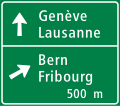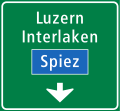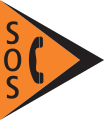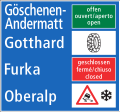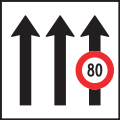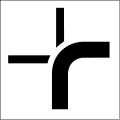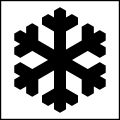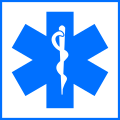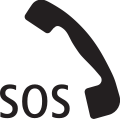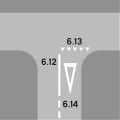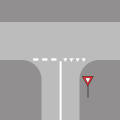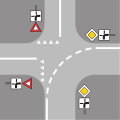Image table of road signals in Switzerland and Liechtenstein since 2016
The picture table of road signals in Switzerland and Liechtenstein since 2016 shows the currently valid catalog of road signals (as of January 15, 2017).
The basis in Switzerland is the Signalization Ordinance of September 5, 1979 (SSV) and in Liechtenstein the Road Signalization Ordinance of December 27, 1979 (SSV).
The signals shown in this illustration are used on Swiss and Liechtenstein territory, with the exception of dirt roads in Tägermoos , where German signals are used (see article on this ).
The catalog below is from 2016; all adjustments since the regulation was introduced on January 1, 1980 have been taken into account. For the catalog as of January 1, 1980 and the chronology of all changes since then as well as future adjustments, see the illustration of road signals in Switzerland and Liechtenstein from 1980 to 2016 .
structure
The structure below is based on the structure in the signaling catalog in Appendix 2 of the SSV (as of January 15, 2017).
| category | shape | No. | Art | colour | Example (s) | ||
|---|---|---|---|---|---|---|---|
| frame | background | content | |||||
| 1. Hazard signals | triangular | 1.01-1.18 | a) Dangerous road system | red | White | black |
|
| 1.22-1.32 | b) Other dangers |
|
|||||
| 2. Regulatory signals | round | 2.01-2.20 | a) Driving bans, size and weight restrictions | red | White | black |

|
| differently | 2.30-2.59.6 | b) Driving orders, parking restrictions | differently |
 
|
|||
| 2.60-2.65 | c) Special paths, bus lanes, light signal system for the temporary regulation of lanes |
 |
|||||
| 3. Right of way signals | differently | 3.01-3.24 | - | differently |
 
|
||
| 4. Warning signals | rectangular | 4.01-4.25 | a) Behavioral advice | white (thin) | green or blue | white or black |

|
| differently | 4.27-4.59.1 | b) Signposting on main and secondary roads | white (thin) | differently | white or black |
|
|
| differently | 4.60-4.73 | c) Signposting on motorways and motorways | white or black (thin) | differently | white or black |
|
|
| rectangular | 4.75-4.91 | d) Information notes | differently |

|
|||
| 5. Additional information on signals | rectangular | 5.01-5.58 | - | black (thin) | White | black |
 |
| 6. Markings and guidance systems | - | 6.01-6.31 | - | - | white yellow blue red |

|
|
design
The size of the signals and markings is defined in Appendix 1 of the SSV. Further details (color, font, permissible variations, layout, etc.) are regulated by the relevant technical standards.
The standard font is ASTRA-Frutiger . Signals set up before 2003 used the SNV font , these are still valid.
If the signal is yellow-black (exception: 3.03 and 3.04), the signal is only valid for drivers of military vehicles ( Art. 101 Para. 8 SSV).
The colors of the bicycle signals are defined as follows: white area is traffic white (RAL 9016), background is ruby red (RAL 3003), the background of the gray end signals is signal gray (RAL 7004), the black lines on the end signals are traffic black (RAL 9017).
Signalization catalog of Switzerland and Liechtenstein from January 15, 2017
With a few exceptions, Switzerland and Liechtenstein have the same road signaling. Exceptions are marked as such.
1.xx danger signals
The danger signals are in accordance with Art. 3 Para. 3 SSV
- in town just before the danger zone. If they are more than 50 meters in front of them, the distance is noted on the attached «distance board» (5.01)
- out of town 150 to 250 meters in front of the danger zone, otherwise the distance is noted on the attached «distance board»
- on motorways and motorways at the danger point itself or at most 100 m beforehand, and also as pre-signals with an attached “distance sign” 500–1000 m in front of the danger point.
The danger signals are intended for drivers who are unfamiliar with the location and should only be placed where a danger cannot be recognized or is recognized too late ( Art. 3 Par. 2 SSV).
The length of the route on which there is a danger can be noted on the attached additional board “Route length” (5.03). The danger signals are repeated on longer stretches, if necessary with the attached «repetition board» (5.04) ( Art. 3 Par. 4 SSV).
- Danger signals
1.06 Uneven road surface
1.10 Dangerous slope
1.14 construction site
1.22 pedestrian crossing
1.31 traffic jam
2.xx regulation signals
- Regulation signals
In other national languages (Switzerland)
Since Switzerland is a multilingual country that counts four national languages (German, French, Italian, Romansh), some of the signals are also available in the other national languages.
- Regulation signals
3.xx right of way signals
"Right of way signals indicate that the driver has to give way to other vehicles or that he has the right of way over other vehicles." ( Art. 35 para. 1 SSV)
- Right of way signals
3.26 Traffic lights at level crossing, Liechtenstein only
( Austrian traffic lights )
4.xx warning signals
Liechtenstein does not contain the tables for 4.58 to 4.73 (motorways and motorways), as Liechtenstein does not have its own motorways and motorways. The location information given in these warning signals for illustration purposes comes from the Swiss Signaling Ordinance. The Liechtenstein Road Signaling Ordinance uses Liechtenstein localities for local destinations and Austrian and Swiss localities near the border for long-distance destinations.
- Warning signals
4.05 Bergpoststrasse
4.08 one-way street
4.09 dead end
4.09.1 Dead end with exceptions (example)
4.11 Location of a pedestrian crossing
4.24 emergency lane (example)
4.34 Signposts for diversions
4:47 sign « camping site »
4.79 campsite
4.83 Breakdown
4.84 gas station
4.89 youth hostel
5.xx Additional information on signals
- Additional information on signals
6.xx markings
- Markings
6.17 pedestrian crossing & 6.18 no-stopping line
Web links
- Overview of road signals on astra.admin.ch
- SR 741.21 Switzerland: Signalization Ordinance of 5 September 1979 (SSV) , current version
- Liechtenstein: Road Signalization Ordinance of December 27, 1979 (SSV) (PDF; 2.7 MB)
Individual evidence
- ↑ Signalization Ordinance of September 5, 1979 (as of January 15, 2017)
- ↑ Liechtenstein: Road Signalization Ordinance of December 27, 1979 (SSV) (PDF; 2.7 MB)
- ↑ rel: «Frutiger» for the street . In: NZZ , January 20, 2003. Retrieved June 28, 2017.
- ↑ Frutiger honored with SOTA award . Microsoft Typography. Retrieved September 1, 2012.
- ↑ VSS SN 640829a, signaling slow traffic
- ↑ Road Signalization Ordinance (SSV) (PDF; 2.7 MB), page 98 ff.

